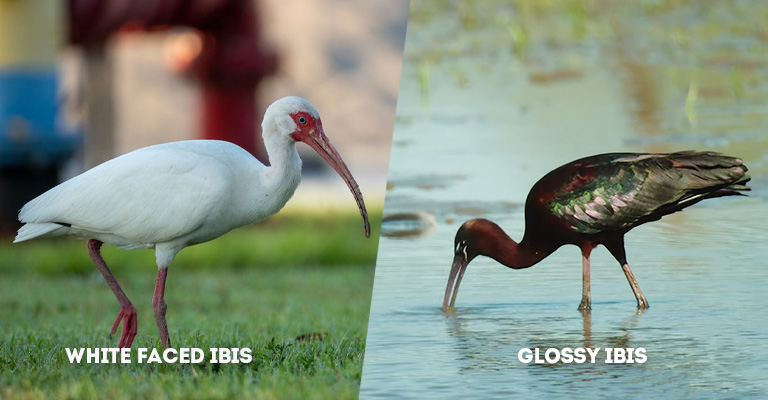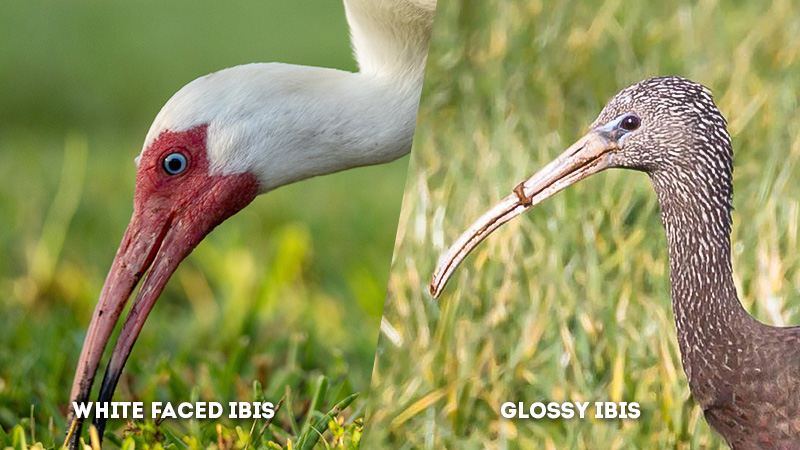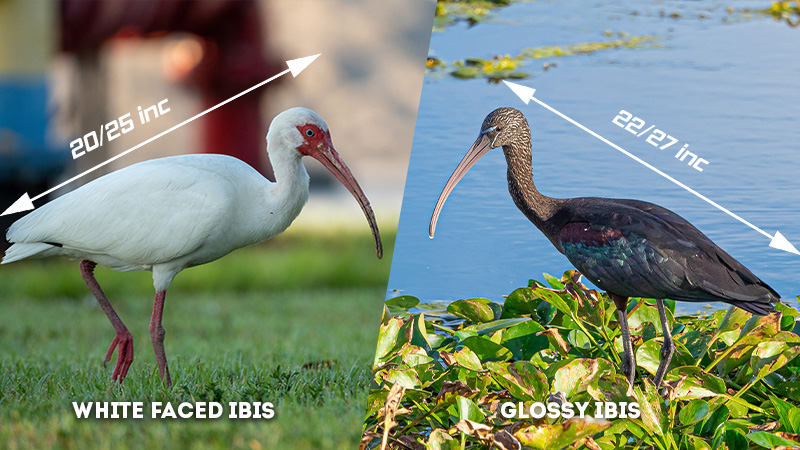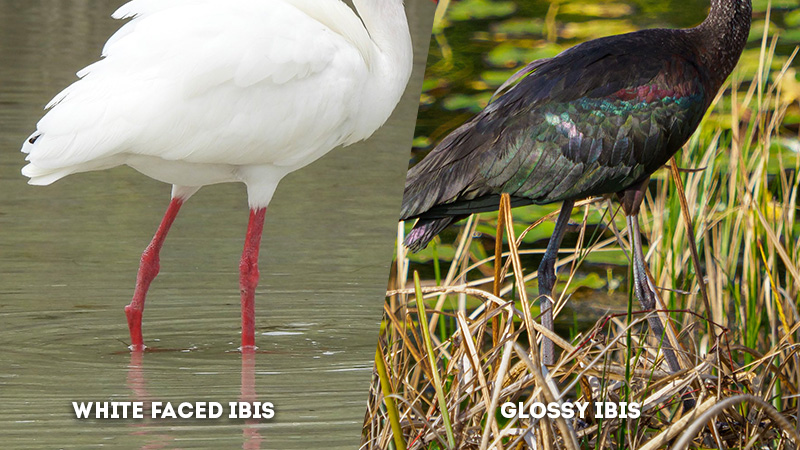The White-faced Ibis and the Glossy Ibis are two distinct avian species belonging to the genus Plegadis. While both ibises share the common traits of wading birds, they exhibit fascinating differences in their physical attributes, behaviors, habitats, and global distributions.
From their plumage and facial features to their feeding strategies and interactions with their environments, these ibises offer a captivating glimpse into the intricate world of wetland ecosystems.
Understanding these distinctions not only sheds light on the diversity of avian life but also underscores the critical roles these species play in maintaining the ecological balance of their respective habitats.

Key Differences Between White Faced Ibis and Glossy Ibis
Facial Patch
- White-faced Ibis: During its breeding season, the White-faced Ibis displays a notable white facial patch on its otherwise dark plumage.
This distinctive white patch contrasts against its reddish-brown eye and adds a striking feature to its appearance. This patch becomes less pronounced in non-breeding periods, accompanied by a shift from bright pink skin to a duller red shade. - Glossy Ibis: Conversely, the Glossy Ibis lacks a white facial patch regardless of its breeding stage. Instead, it showcases a glossy purplish-bronze plumage that gleams iridescently in sunlight. The Glossy Ibis’s dark eye stands out against its captivating plumage, setting it apart from the White-faced Ibis.
Plumage
- White-faced Ibis: The White-faced Ibis boasts a distinctive plumage that undergoes striking changes during its breeding and non-breeding seasons.
During breeding, its dark brown plumage is adorned with a unique white facial patch, which serves as a prominent identifier. This patch contrasts sharply against its reddish-brown eye, creating an eye-catching combination. - Glossy Ibis: In contrast, the Glossy Ibis is renowned for its captivating and iridescent plumage. Displaying shades of purplish-bronze, its feathers gleam with an enchanting sheen when illuminated by sunlight.
This glossy appearance remains consistent across all seasons, contributing to the ibis’s allure. Unlike the White-faced Ibis, the Glossy Ibis lacks a white facial patch, and its eye is notably dark, harmonizing with its radiant plumage.
Eye Color

- White-faced Ibis: An intriguing hallmark of the White-faced Ibis is its reddish-brown eye. This distinctive eye color remains consistent throughout its various plumage stages.
Whether during breeding or non-breeding periods, the vibrant hue of its eye contrasts vividly with its plumage, making it a readily distinguishable feature. - Glossy Ibis: The Glossy Ibis stands apart with its dark eye, which serves as a striking counterpoint to its glossy plumage. Regardless of the season or its location, the Glossy Ibis consistently displays a dark eye, further enhancing its elegant and captivating appearance.
Habitat
- White-faced Ibis: White-faced Ibises prefer wetland habitats as their primary dwelling places. Thriving in environments such as marshes, ponds, and mudflats, these ibises have a strong affinity for aquatic locales.
These habitats provide the essential resources required for their foraging activities and breeding behaviors. - Glossy Ibis: Glossy Ibises are versatile in their habitat preferences, occupying a broader range of wetland environments.
They can be found in both freshwater and saltwater marshes, swamps, and shallow lagoons. This adaptability allows them to inhabit diverse ecosystems across the globe.
Distribution
- White-faced Ibis: The White-faced Ibis is mainly distributed across western North America, extending into parts of Central and South America. This range encompasses regions with suitable wetland habitats that facilitate their feeding and nesting habits.
- Glossy Ibis: In contrast, the Glossy Ibis boasts a more extensive global distribution. These birds can be found in various continents, including North America, Europe, Africa, Asia, and even Australia.
This widespread presence underscores their adaptability and ability to thrive in diverse geographical settings.
Size

- White-faced Ibis: The White-faced Ibis measures around 20 to 25 inches (50 to 64 cm) in length, presenting a compact yet graceful appearance. This size range contributes to their suitability for maneuvering through wetland environments while foraging.
- Glossy Ibis: Comparatively, the Glossy Ibis is slightly larger, with a length of about 22 to 27 inches (55 to 68 cm). This size difference is often observable in the field and assists in distinguishing between the two species.
Bill Shape
- White-faced Ibis: Both ibis species share a distinct feature – their curved bills. The White-faced Ibis’s bill is adapted for probing the water and mud for food. This curved shape aids in capturing aquatic invertebrates and other prey items.
- Glossy Ibis: Likewise, the Glossy Ibis boasts a similar curved bill design. With this specialized tool, they effectively sift through mud and water to uncover insects and small vertebrates, contributing to their successful foraging strategies.
Migration
- White-faced Ibis: White-faced Ibises display varying migration patterns depending on their location. Populations in northern regions often migrate southward during colder months to seek more favorable conditions for feeding and breeding.
- Glossy Ibis: Glossy Ibises also exhibit migratory behavior, although this varies among different populations and regions. Some Glossy Ibises are migratory, while others remain resident throughout the year in their chosen habitats.
Voice
- White-faced Ibis: The White-faced Ibis is known for its distinctive vocalizations, characterized by harsh and grating calls. These calls serve various purposes, including communication within flocks and during territorial disputes.
- Glossy Ibis: Glossy Ibises communicate through a range of vocalizations, including croaks, grunts, and calls. These calls may vary depending on social interactions, environmental conditions, and breeding behaviors.
Breeding Behavior
- White-faced Ibis: During the breeding season, White-faced Ibises form colonies and construct nests in trees or bushes, often near water sources. Their nests are composed of sticks and reeds, providing a secure environment for raising their chicks.
- Glossy Ibis: Glossy Ibises also adopt colony nesting behaviors. They build their nests in reeds or other vegetative cover found within wetland habitats. These nests offer protection and camouflage for their eggs and offspring.
Breeding Display
- White-faced Ibis: During the breeding season, the White-faced Ibis engages in captivating displays to attract potential mates. One of the most notable behaviors is the enhancement of its white facial patch.
This patch becomes more prominent and conspicuous, serving as a visual cue to potential partners. The dynamic changes in the facial patch contribute to a mesmerizing display that is characteristic of the species. - Glossy Ibis: The Glossy Ibis exhibits a less pronounced breeding display compared to the White-faced Ibis. Instead of relying on a dramatic change in plumage or facial features, Glossy Ibises emphasize other aspects of their behavior, such as vocalizations and body postures, to communicate their reproductive readiness.
Nest
- White-faced Ibis: White-faced Ibises construct their nests in trees or bushes, often situated near water bodies such as marshes or ponds.
These nests are artfully woven using sticks and reeds, forming a sturdy platform that cradles their eggs and nestlings. The strategic placement of nests in vegetation provides protection from potential predators. - Glossy Ibis: Glossy Ibises, similarly, create nests within wetland habitats, but they tend to choose areas with more abundant reeds and vegetation. Their nests are also constructed using sticks and vegetation, offering concealment and safety for their offspring during the crucial breeding period.
Egg Color
- White-faced Ibis: The eggs of White-faced Ibises feature a range of colors, typically in shades of blue-green to olive. This coloring blends well with the surrounding vegetation, providing natural camouflage that helps protect the eggs from predators.
- Glossy Ibis: In contrast, the Glossy Ibis lays eggs with a bluish-green to pale-green coloration. This subtle color variation is consistent with their preference for nesting in reedy environments, where the eggs’ coloring harmonizes with the surrounding plant matter.
Incubation Period
- White-faced Ibis: The incubation period for White-faced Ibises lasts around 20 to 22 days. During this critical phase, one or both parents diligently tend to the eggs, ensuring they remain warm and safe from potential threats.
- Glossy Ibis: Glossy Ibises follow a similar incubation period, lasting around 21 to 23 days. The commitment of the parents to maintaining the proper temperature and humidity within the nest is essential for the successful development of the eggs.
Chick Appearance
- White-faced Ibis: Upon hatching, White-faced Ibis chicks display downy grayish plumage with darker markings. This coloration provides an initial layer of camouflage and protection as they nestle within the nest, concealed from potential predators.
- Glossy Ibis: Glossy Ibis chicks exhibit downy plumage as well, but their appearance leans toward a brownish hue with darker streaks. This variation in coloration aligns with the habitat choices of Glossy Ibises and aids in blending with the reeds and vegetation surrounding their nests.
Feeding Habits
- White-faced Ibis: The White-faced Ibis is a skilled forager, primarily seeking aquatic invertebrates, insects, and small fish in shallow waters. Its curved bill is well-suited for probing mud and water, allowing it to extract prey with precision.
These feeding habits support its energetic requirements during both breeding and non-breeding seasons. - Glossy Ibis: Similar to the White-faced Ibis, the Glossy Ibis is an adept forager with a preference for insects, small vertebrates, and aquatic prey. Their specialized curved bill aids in capturing their chosen food items from wetland habitats. Both species share a reliance on these feeding strategies for sustenance.
Social Behavior
- White-faced Ibis: White-faced Ibises often exhibit social behavior by foraging in flocks. This group activity allows them to effectively locate and capture prey items in wetland environments.
They also engage in cooperative behaviors, benefiting from the safety and collective awareness that comes with being part of a flock. - Glossy Ibis: Glossy Ibises also display social behavior through flocking. These mixed species flocks might include other ibis species, herons, and other wading birds. The synergy within these flocks assists in both foraging and safety, providing additional protection against potential threats.
Range Overlap
- White-faced Ibis: The range of the White-faced Ibis overlaps with that of the Glossy Ibis in some areas, particularly in parts of North America where both species can be found coexisting in wetland habitats.
Despite this overlap, distinct habitat preferences and behaviors often differentiate their exact locations within shared regions. - Glossy Ibis: Glossy Ibises also share some geographical range with the White-faced Ibis, contributing to interspecies interactions in these areas. However, their differing habitat adaptations often result in specific microhabitats within overlapping regions.
Migration Patterns
- White-faced Ibis: White-faced Ibises exhibit varying migration patterns depending on their geographic location.
Populations in northern areas tend to migrate southward during colder months, seeking more favorable conditions for feeding and breeding. This migratory behavior reflects their need to adjust to changing environmental conditions. - Glossy Ibis: Glossy Ibis populations have diverse migration patterns. While some Glossy Ibises undertake long-distance migrations, others remain resident throughout the year in their chosen habitats.
This variability in migration strategies showcases the flexibility of the species to adapt to different environments and availability of resources.
Lifespan
- White-faced Ibis: White-faced Ibises typically have a lifespan of around 10 years in the wild. Survival rates are influenced by factors such as habitat quality, predation, and environmental conditions. Their relatively short lifespan underscores the challenges they face in their wetland habitats.
- Glossy Ibis: The lifespan of Glossy Ibises can vary due to environmental factors. While their lifespan might also hover around 10 years, some individuals can live longer under favorable conditions. The interplay of habitat quality, food availability, and the presence of predators contributes to the variations in their lifespans.
Conservation Status
- White-faced Ibis: The White-faced Ibis holds a conservation status of “Least Concern” according to the International Union for Conservation of Nature (IUCN).
While certain populations may face localized threats due to habitat loss and human disturbance, the species as a whole benefit from its adaptable nature and relatively stable numbers. - Glossy Ibis: The Glossy Ibis’s conservation status ranges from “Least Concern” to “Near Threatened” depending on the region.
While some populations are secure and thriving, others are facing declines due to habitat degradation, pollution, and disturbance. These discrepancies highlight the varying conservation needs of different Glossy Ibis populations.
Diet
- White-faced Ibis: White-faced Ibises have a diet predominantly consisting of aquatic invertebrates, insects, and small fish.
Their specialized curved bill allows them to forage efficiently in shallow waters, probing mud and water to extract their chosen prey. This diet adaptation enables them to exploit wetland ecosystems as primary food sources. - Glossy Ibis: Glossy Ibises share a similar diet composition with the White-faced Ibis, relying on insects, small vertebrates, and aquatic prey.
Their curved bill is also a valuable tool for capturing these food items, indicating convergence in feeding strategies across these species.
Leg Color

- White-faced Ibis: The White-faced Ibis’s leg color varies from gray to grayish-pink. This coloration complements their plumage and blends well with the muddy and watery environments they frequent during their foraging activities.
- Glossy Ibis: Glossy Ibises exhibit leg colors that range from gray to brownish-gray. Like the White-faced Ibis, this color variation provides camouflage within their preferred wetland habitats, enhancing their ability to remain concealed from potential predators.
Behavioral Adaptations
- White-faced Ibis: White-faced Ibises exhibit a set of behavioral adaptations that make them well-suited to wetland environments. Their ability to forage in flocks helps them locate and capture prey more effectively.
Additionally, their specialized bill shape enables them to navigate muddy and watery substrates to access their food sources. - Glossy Ibis: Glossy Ibises showcase similar behavioral adaptations, relying on foraging in flocks and utilizing their curved bills to access prey in wetland habitats. These shared behaviors highlight the evolutionary convergence of strategies that enable them to thrive in similar ecological niches.
Mating Season
- White-faced Ibis: The mating season for White-faced Ibises typically occurs during the spring and summer months.
This period sees an increase in breeding behaviors, such as the enhancement of the white facial patch. The availability of suitable nesting sites and food resources often influences their timing of reproduction. - Glossy Ibis: Glossy Ibises also experience a mating season that varies depending on the region and habitat. They may breed during different parts of the year, adjusting their reproductive behaviors to coincide with favorable environmental conditions and resource availability.
Flock Behavior
- White-faced Ibis: White-faced Ibises demonstrate a tendency to forage and move in flocks. This social behavior enhances their safety and aids in locating food resources. Flocking also facilitates information sharing about suitable feeding grounds and potential threats.
- Glossy Ibis: Glossy Ibises share this flocking behavior, often forming mixed-species flocks with other wading birds and ibis species. This collective behavior provides mutual benefits, allowing them to find food sources, avoid predators, and engage in social interactions.
White Faced Ibis Vs Glossy Ibis: Comparison Table
| Feature | White-faced Ibis | Glossy Ibis |
|---|---|---|
| Facial Patch | White patch on face during breeding season | No white facial patch |
| Plumage | Dark brown with white during breeding | Glossy purplish-bronze, iridescent plumage |
| Eye Color | Deep red throughout plumage variations | Dark eye in all plumages |
| Habitat | Wetlands, marshes, ponds | Freshwater and saltwater marshes, lagoons |
| Distribution | Western North America, Central/South America | Global distribution: Europe, Africa, Asia, Australia |
| Size | About 20-25 inches (50-64 cm) in length | About 22-27 inches (55-68 cm) in length |
| Bill Shape | Curved, used for probing mud/water | Curved, used for feeding in water/mud |
| Migration | Migratory in some parts of the range | Can be migratory or resident |
| Voice | Harsh, grating calls | Variety of croaks, grunts, and calls |
| Breeding Behavior | Colonies, nests in trees/bushes | Colonies, nests in reeds/vegetation |
| Breeding Display | White facial patch more prominent | Display behaviors less pronounced |
| Nest | Platform of sticks, reeds | Platform of sticks and vegetation |
| Egg Color | Blue-green to olive | Bluish-green to pale green |
| Incubation Period | Around 20-22 days | Around 21-23 days |
| Chick Appearance | Downy, grayish with dark markings | Downy, brownish with darker markings |
| Feeding Habits | Forages in shallow water for invertebrates | Probes mud/water for insects, crustaceans |
| Social Behavior | Often forages in flocks | Often seen in mixed species flocks |
| Range Overlap | Overlaps with Glossy Ibis in some areas | Overlaps with White-faced Ibis in some areas |
| Migration Patterns | Northern populations migrate southward | Migration patterns vary by region |
| Lifespan | Around 10 years in the wild | Variable, depending on environmental factors |
| Conservation Status | Least Concern (IUCN) | Least Concern to Near Threatened (IUCN) |
| Diet | Aquatic invertebrates, insects, small fish | Insects, small vertebrates, aquatic prey |
| Leg Color | Gray to grayish-pink | Gray to brownish-gray |
| Behavioral Adaptations | Wading, probing for food in shallow water | Skilled foragers in a range of wetland habitats |
| Mating Season | Spring to summer | Varies by region and habitat |
| Flock Behavior | Often forms large flocks | Variable flock sizes |
Frequently Asked Questions
Yes, both ibis species are known to interact with other bird species in their wetland habitats. They often form mixed-species flocks with other wading birds, enhancing their collective safety and foraging success through mutual information sharing.
Both ibis species exhibit flexibility in their migration patterns. Some individuals of both species migrate long distances to seek suitable feeding and breeding conditions, while others choose to remain resident year-round, adapting to their local environments and resource availability.
While both species can face habitat degradation, pollution, and disturbance, the extent of vulnerability varies. White-faced Ibises may be impacted by habitat loss and human activity, whereas Glossy Ibises can face threats such as changes in water quality and habitat destruction in their diverse range of habitats worldwide.
Both species communicate through a variety of vocalizations. These calls serve to coordinate movements within the flock, alert others to potential dangers, and convey information about food sources. The vocal repertoire contributes to their effective functioning within the group.
Yes, they do. White-faced Ibises display an eye-catching white facial patch during breeding as part of their courtship behavior. In contrast, Glossy Ibises rely on a combination of vocalizations, body postures, and sometimes visual displays to communicate their readiness to potential mates during their mating seasons.
To Recap
The White-faced Ibis and the Glossy Ibis exemplify the remarkable adaptations that arise from nature’s diversity. Their contrasting appearances, behaviors, and responses to their environments provide invaluable insights into avian evolution and ecosystem dynamics.
These ibises, with their distinctive traits, underscore the importance of preserving wetland habitats and the myriad species that rely on them.
By appreciating the unique attributes of these two ibis species, we deepen our understanding of the delicate relationships that shape the natural world and inspire our commitment to conservation for generations to come.